Miscanthus: varieties, planting and care
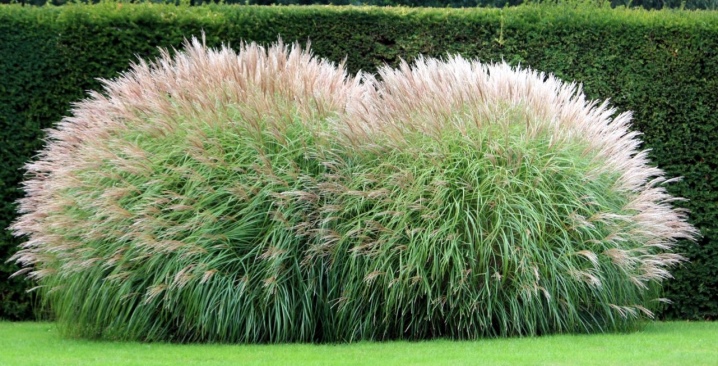
Decorative miscanthus becomes a decoration for any garden. The unusual appearance of the culture pleases the eye throughout the year, even in winter.
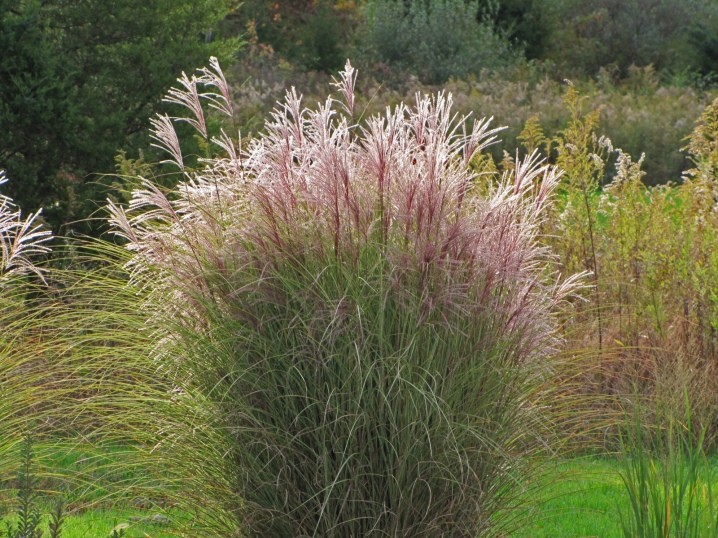
Description
Miscanthus, also known as fan, is a herbaceous plant, the height of which ranges from 80 to 200 centimeters. The volumetric root system deepens by almost 6 meters, but horizontal branches are also observed near the surface, requiring regular irrigation. The foliage on the decorative cereal forms a voluminous basal rosette, and is also located along the entire length of the trunk. The width of the plate ranges from 5 to 18 millimeters, and the length is approximately 10-50 centimeters. The green mass changes its hue in the fall to yellowish or pink.
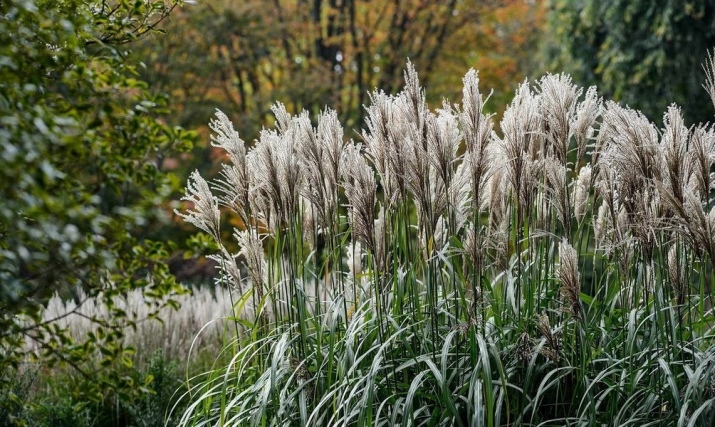
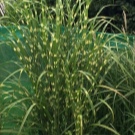
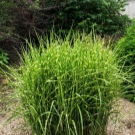
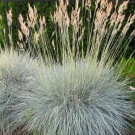

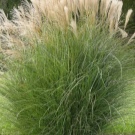
The miscanthus flower is a neat panicle 15 to 30 centimeters long. It has different colors and is formed from individual long spikelets arranged in a fan.
Types and varieties
There are about forty varieties of miscanthus in total, but not all of them can be used in horticulture. The most popular in Russia are the following types:
- Chinese;

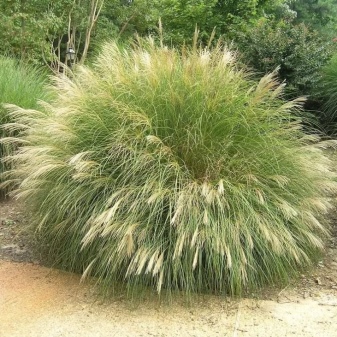
- sugar-flowered;

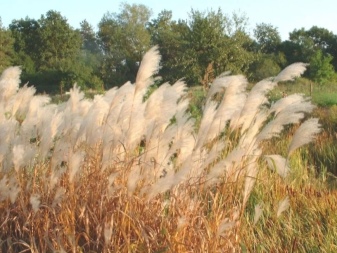
- giant.
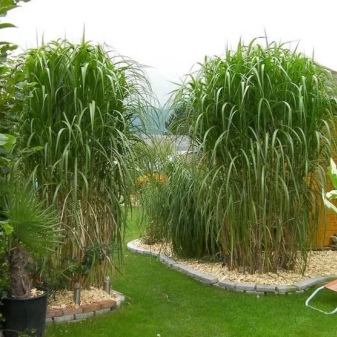
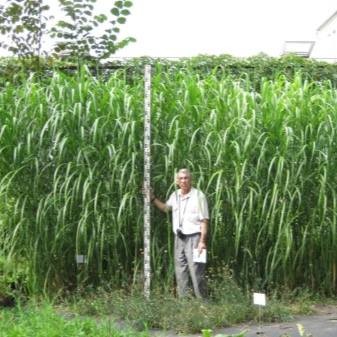
Chinese fan variegatus is especially in demand among gardeners. It has excellent resistance to low temperatures. It grows almost 3 meters high with a very short root system. The narrow leaves have a rough surface and are divided in half by a longitudinal rib. In autumn, the plates acquire a reddish or yellow color. The spikelet panicles themselves are colored pink, red or silver. The flowering of the Chinese fan lasts from August to October. Each of the varieties of this species has its own characteristics.
- Flamingo variety withstands cold down to -29 degrees without additional insulation. The stem extends up to 2 meters, and the pink flowers grow much larger.

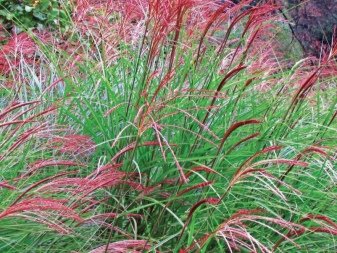
- "Klein Fountain" has only a meter in height. Kleine Fontane has a standard size brown panicle.
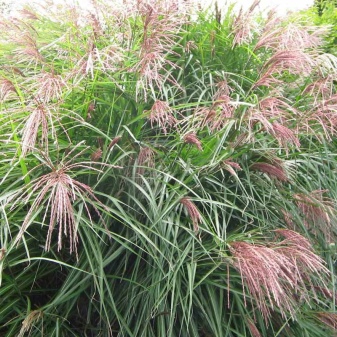

- "Malepartus" blooms quite early. Burgundy flowers located on panicles, closer to autumn change their shade to bright red. Green leaf plates at this time change to golden with an orange tint. The plant is about 2 meters high.
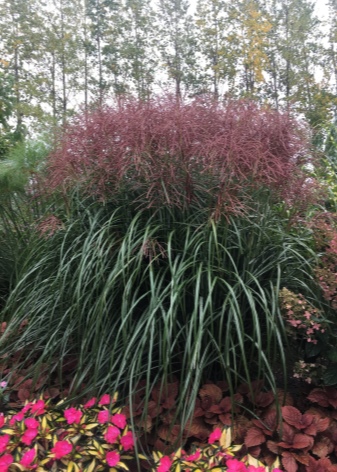
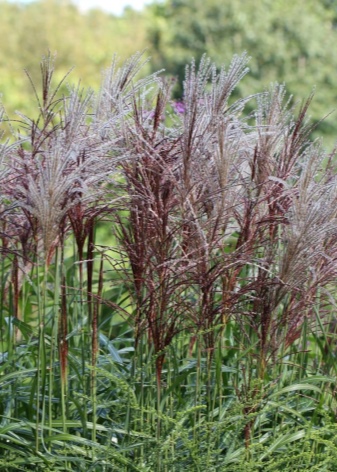
- Rothsilber characterized by the presence of red leaves and panicles, which change to orange by autumn.
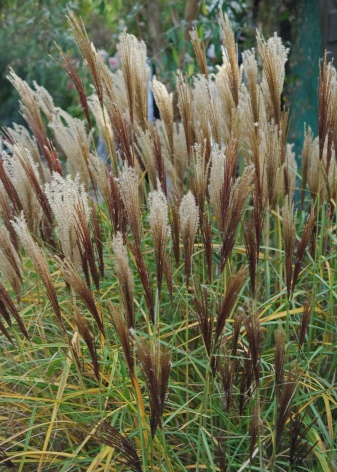
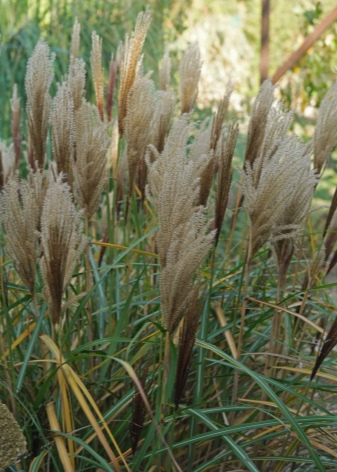
- Variety "Zebrina", which is often called Zebrinus miscanthus, has an extremely unusual leaf color - narrow plates are covered with either yellow or beige transverse stripes. The panicles are painted in brick tone. The culture stretches up to 2 meters in height. The most abundant flowering takes place in September.
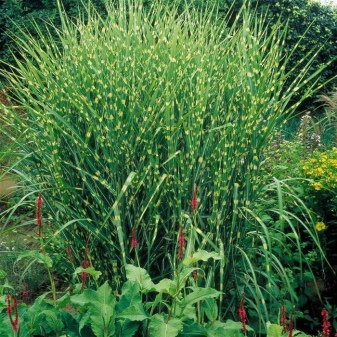
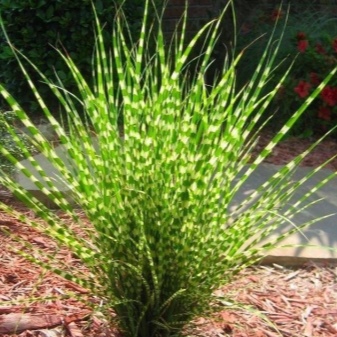
- Miscanthus "Variegata" in height ranges from one and a half to two meters. The reddish flowers are beautifully combined with long white-green leaves.

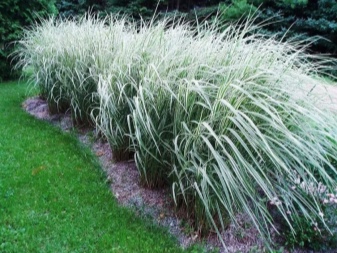
- Variety "Strictus" grows almost 2.7 meters. The width of the leaf plates, painted with white and green stripes, is one and a half centimeters. Loose panicles are pale red.

- "Gold bar" has a height equal to one and a half meters. Narrow leaf plates are covered with beige stripes. The panicles blooming on the bush at the end of summer have a beautiful wine tint.

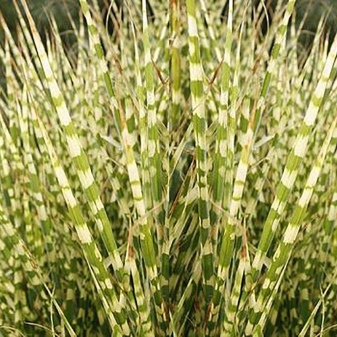
- "Purpurescens" also does not differ in great height - only one and a half meters. Gray-green leaves by autumn change color to orange-red. Purple inflorescences turn white over time.


- Miscanthus "Gracilimus" loves shade and it is in a darkened space that it is able to reach a height of two meters. Flowering begins at the end of September, and the panicle shade is classic red.
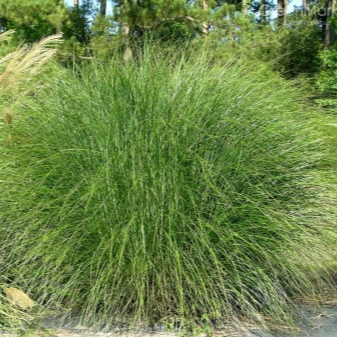

- Rother pfeil variety has a one and a half meter height. Purple leaves are accompanied by red-pink inflorescences that change their color to silver. This variety blooms for a long time - from August to October.
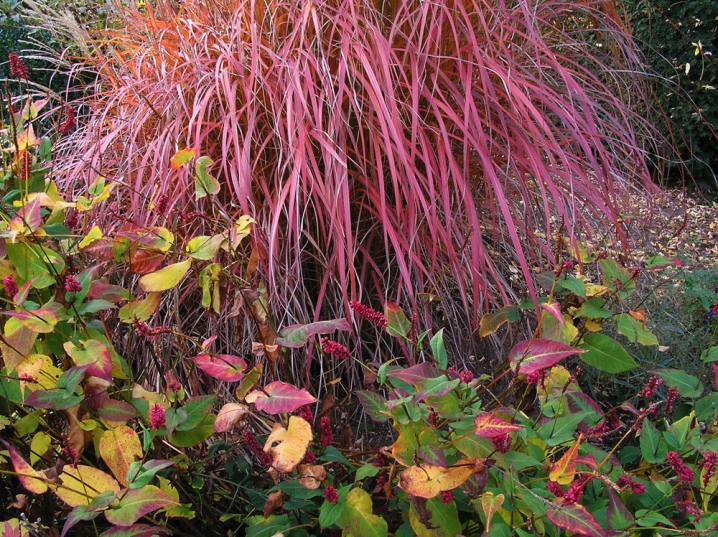
- Variety "Moning light", aka Morning Light, is one of the oldest. The height of the plant, like many, is only 1.5 meters. Flowering starts in September, when the spikelets have a red-pink tint.
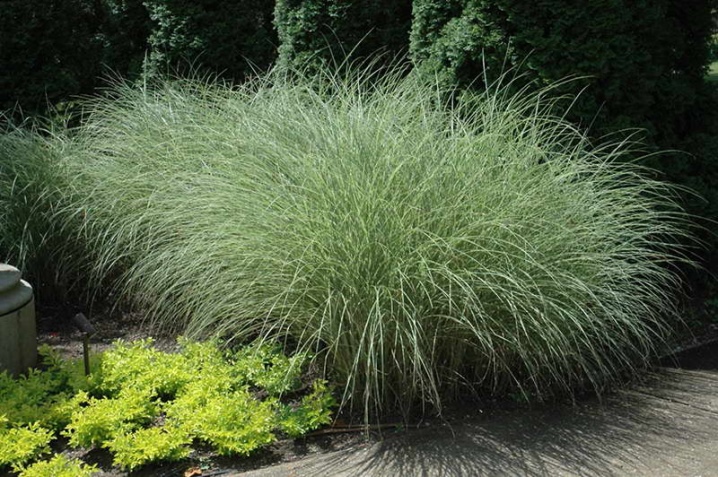
- For the grade "Graziella" the change of the green shade of the leaf plates to crimson is characteristic, as well as the coloring of the brushes in a cream shade. This fan does not tolerate shade well, so it is important to plant it in open spaces.
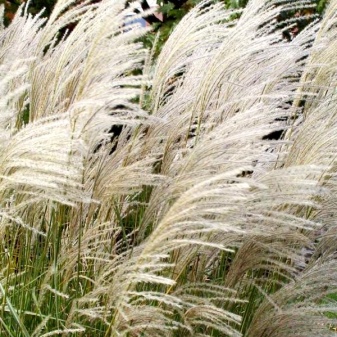
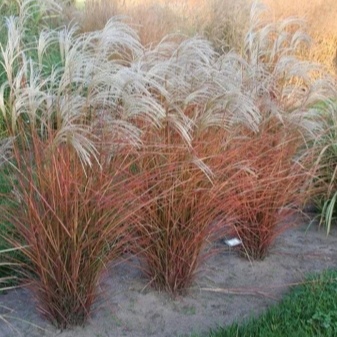
The height of the shrub is one and a half meters.
- Miscanthus "Silberfeder" possesses feathery leaf plates, the width of which is about two centimeters. Their color changes from pink to silver during the growing season. Panicles are formed in August.

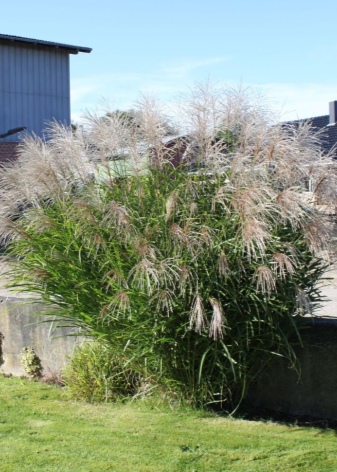
- Variety "Pearl Fall" ranges from one and a half to two meters in height. Flowering begins in early autumn and is accompanied by the appearance of red-pink panicles. The color of the leaf plates takes on a lilac hue in autumn.
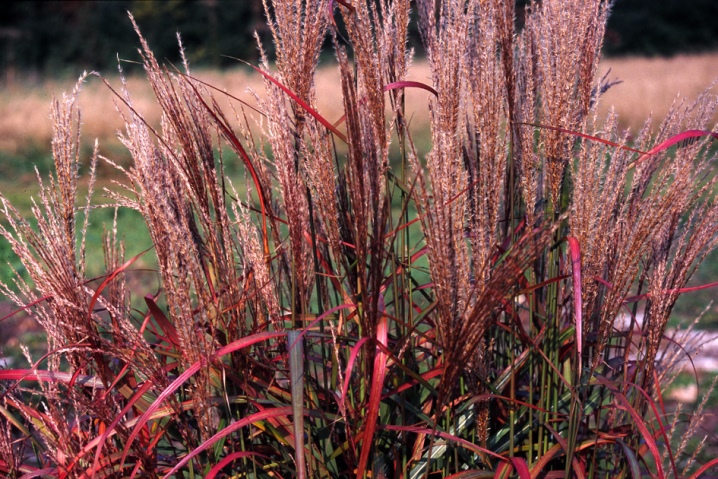
- "Adagio" is short and only 80 centimeters high. Narrow leaf plates change their color from silver to yellow. The color of the inflorescences changes from pink to cream.
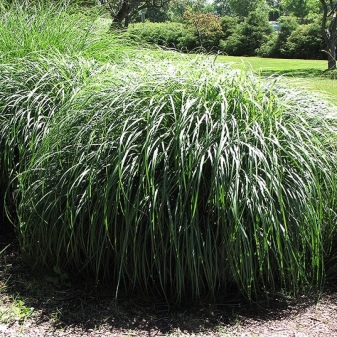

The sugary species of miscanthus is characterized by the presence of smooth stems 2 meters high, on which narrow leaf blades grow. The shade of the panicles can be either pink or light silver. This sugar species begins to bloom in July.
The giant fan is a hybrid species. Long leaf plates hanging from straight stems are dark-colored. There is a light longitudinal edge in the center of each plate. Giganteus is able to withstand winter temperatures as low as -34 degrees. Popular varieties of miscanthus are Cascade, Ferner Osten, Alligator, Gross Fountain, Adagio, Red Chief.

Subtleties of landing
Although planting miscanthus outdoors is basically the same, the timing may vary from region to region.
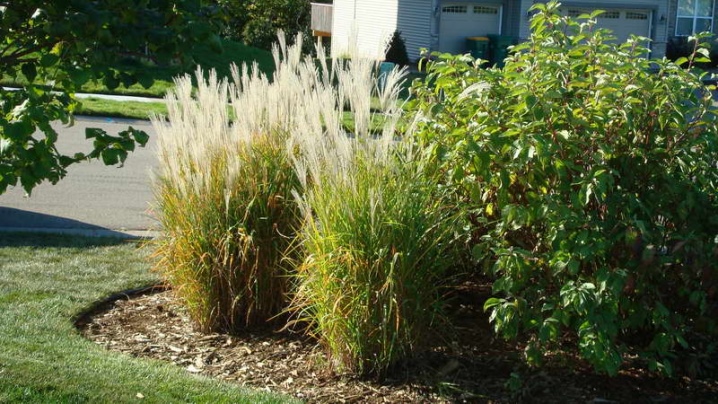
Optimal timing
The planting of the fan is carried out in the spring, when the earth warms up enough, and the threat of the return of frosts recedes. In the south, planting can already begin from late March to early April, and in the middle lane, for example, in the Moscow region, you will have to wait until the first weeks of May. In Siberia, planting operations begin no earlier than the end of May.
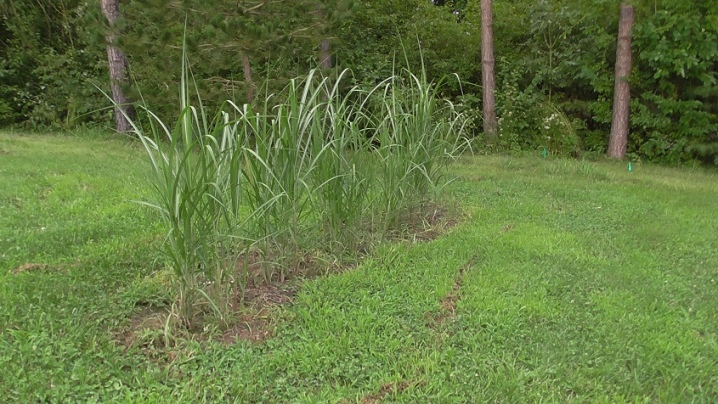
Seat selection
For the successful development of miscanthus, light and moisture are most important. Landing in open and well-lit areas located close to water bodies is considered optimal. The fan does not put forward special conditions for the composition of the soil, but it will have problems with clay and sand. Therefore, such areas should be enriched with humus, peat or compost.
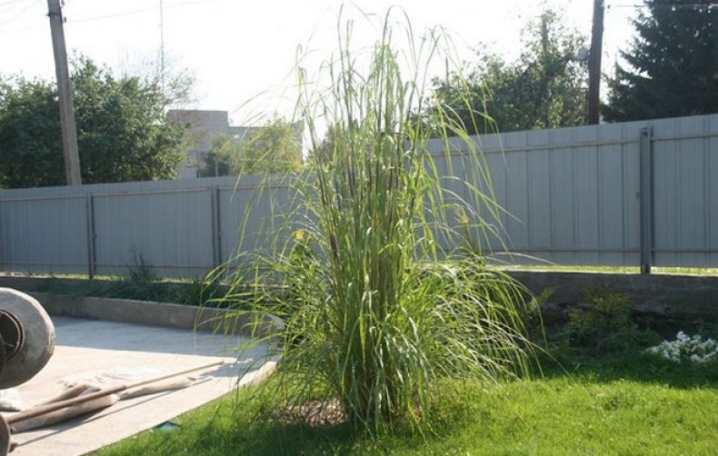
It is recommended to make sandy soils heavier with river silt and clay, while clay soils, on the contrary, should be lightened with sand and peat.
Instructions
Planting miscanthus outdoors is fairly straightforward. The hole is dug in such a way that both the depth and width are slightly larger than that of the root system. The pit is filled with a nutrient mixture consisting of garden soil, humus and compost. After that, an adult seedling is placed inside, and its roots are gently straightened. Next, the pit is filled with the remaining soil, slammed and watered abundantly.
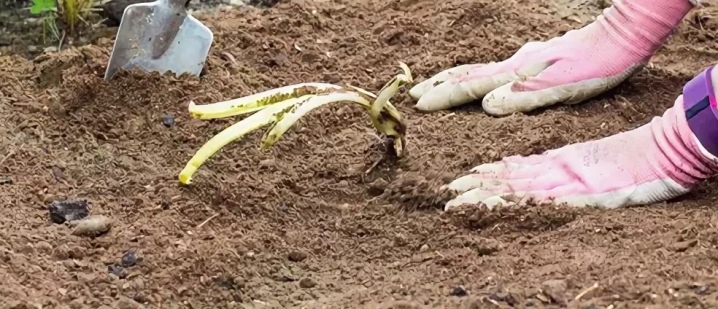
How to take care of it properly?
Care for miscanthus must be especially careful, until the plant turns 3-4 years old, since the development of culture depends on the procedures carried out... Further, all activities will mainly work on the decorative effect of the shrub.

Watering
Irrigation of plantings should be regular and abundant. It is better to focus on the condition of the soil and adjust the procedure depending on the circumstances. If the summer is dry, then the fan has to be watered every day, sometimes even in the morning and in the evening. The moisture should go 30-40 centimeters deep so that the root system receives the required amount of liquid. Watering, as well as spraying, should be carried out either early in the morning or late in the evening, so that the combination of bright sunlight and liquid on the surface does not provoke burns. A garden hose can be used to care for thick stems. Despite the fact that the culture reacts very badly to drought, stagnant moisture in the soil will also be detrimental to the roots.

Top dressing
As a rule, in the first year of life, miscanthus has enough of the fertilizers that were applied during planting. Starting next year, fertilizing should take place a couple of times in each season. In mid-May, two tablespoons of urea are diluted in a ten-liter bucket of water and used for irrigation so that nitrogen contributes to the development of green mass. At the beginning of June, it is recommended to add a solution of humates, following the attached instructions. Finally, in the second half of summer, the fan should be fed with a product containing potassium and phosphorus to stimulate flowering.
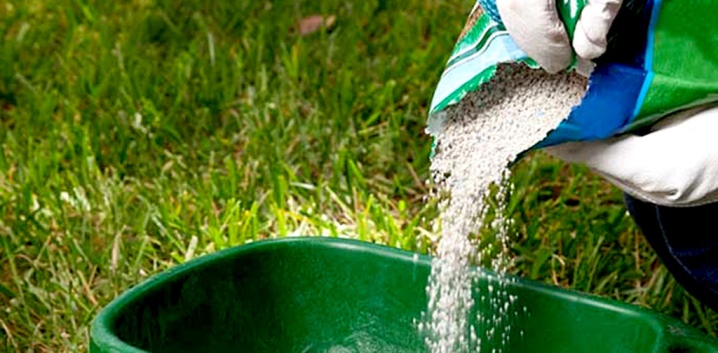
In order not to harm the roots and not provoke an overdose, all fertilizers should be applied after irrigation.
Loosening and mulching
Mulching the soil is necessary in order to retain moisture inside, but not contribute to the formation of an earth crust. Mulch also helps protect against weeds. Humus, peat, freshly cut young nettles, dandelion greens or other weeds are used as the main material. The mulch layer is at least 3 centimeters. Loosening is carried out after irrigation and contributes to a better transfer of oxygen to the root system.
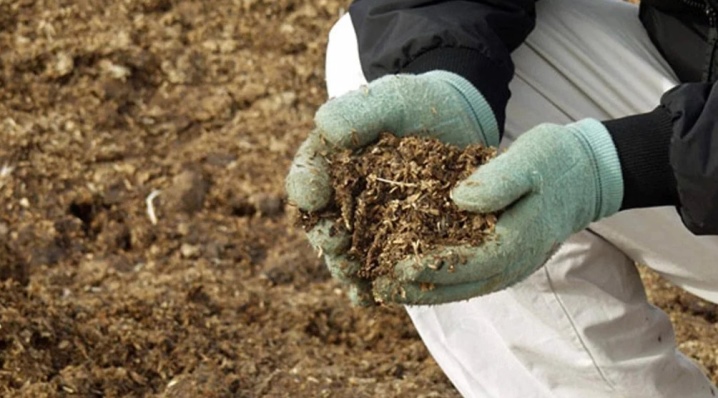
Weeding
The weeds must be harvested in the early years of the miscanthus' life, until the plant is strong enough to resist the weeds on its own. It is better to carry out weeding a couple of times a week, accompanying the procedure by loosening the earth. An adult Miscanthus, that is, the one who is 3-4 years old, will cope with the “competitors” on its own.
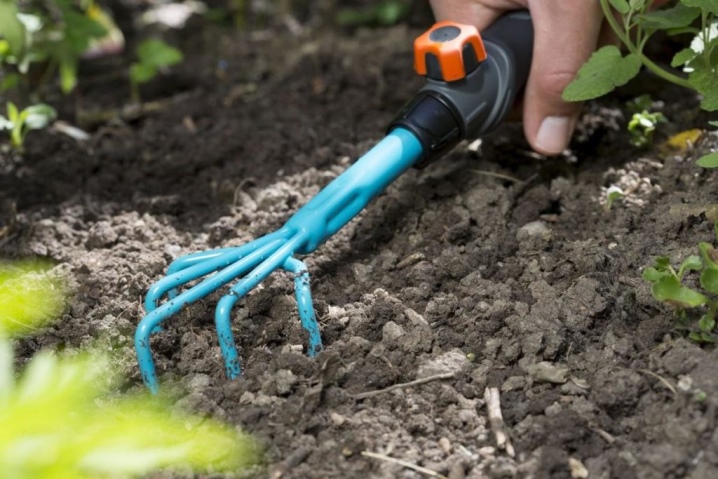
Pruning
To make the bushes of miscanthus look beautiful, a simple pruning, carried out in the spring, when last year's stems are removed, is enough. In the fall, such a procedure should not be carried out, since if moisture penetrates into the remaining "hemp" in winter, decay of the root system will begin.
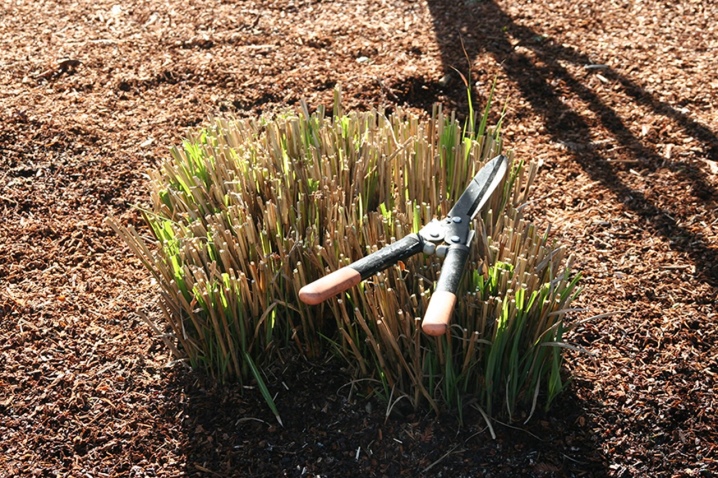
Cutting off the stems in the fall is not required.
Wintering
The frost resistance of most varieties of miscanthus is such that it can withstand cold snaps down to -20 degrees without any problems, but when the temperature decreases, it still requires additional measures. Both young and adult plants must be mulched before the onset of the first frost. The mulch layer should be 10 to 15 centimeters long and consist of peat, sawdust, compost or leaf litter. In case of expected severe frosts, the upper part of the bush is wrapped in a special non-woven material, which is then tied at the base of the bump. If the region has cold winters, then a full-fledged shelter from plastic wrap, boards, dry leaves and sphagnum can be made for the shrub.

Reproduction methods
Miscanthus is propagated in two main ways: either by dividing the bush or by seeds.

By dividing the bush
If division is chosen for reproduction of the culture, then it will be possible to use it on one shrub only once every three or four years.The shrub should be divided from April to June. The healthiest and most resistant specimen is selected, which is divided into the required number of parts with a sharp knife. It is important to leave a full-fledged root and 5-6 shoots for each delenka. The resulting miscanthuses are either immediately planted in a new place, or they are kept in a cool place for several days, and then they are already moved into open ground. The immersion depth of the cut should be 6 centimeters.

Seeds
If the seeds are planted to obtain seedlings, then it is worth starting the procedure in the fall. It is more convenient to use peat pots or other small containers that will only hold one or two seeds each. The containers are filled with ordinary nutrient mixture, and the seed is deepened by no more than a centimeter. Next, the plantings are irrigated, and the pots are rearranged where there is good lighting. Immediately it is worth puzzling to create a greenhouse using cling film or a glass sheet. As soon as shoots appear, the cover must be removed.
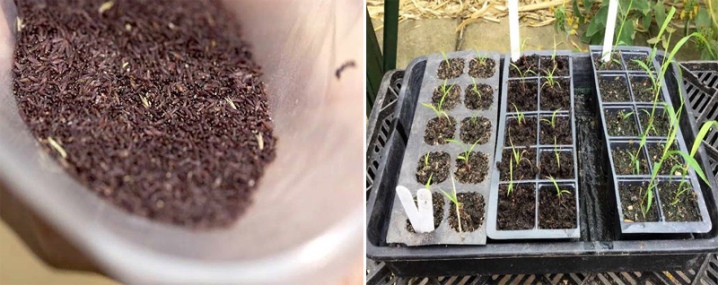
Until spring, seedlings should be kept at a temperature of 20 degrees Celsius. To create the required length of daylight hours, it is better to use special lamps. Watering should be regular, but carried out only when the earthen lump dries out, that is, one should focus on the current state of the soil. Landing in open ground is carried out when warm weather sets in, and there will be no need to fear the return of frost. The plants will need to be pre-tempered by taking them outside for an interval from 2 hours to the whole night.
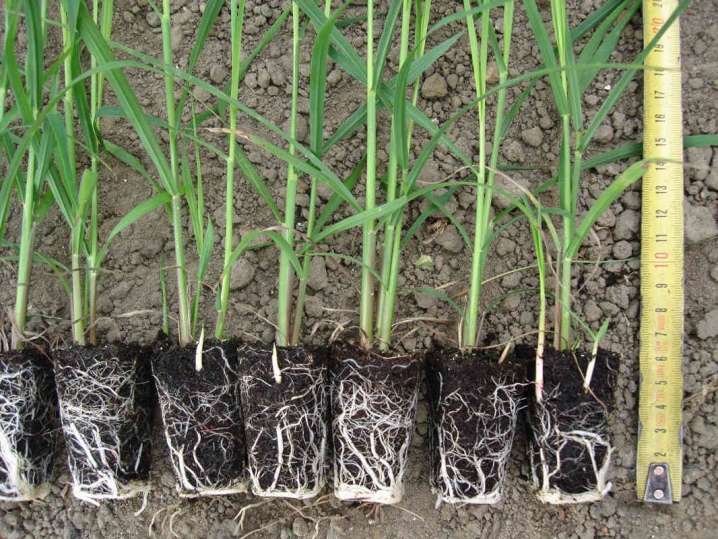
It should be noted that the seed propagation method is not particularly effective. Seed material is rather difficult to collect due to its miniature size, and decorative characteristics disappear in most cases. In addition, for the bush to develop to a good size, you will have to wait 3 to 4 years.
Diseases and pests
One of the main advantages of miscanthus is its highest resistance to various diseases and insects. Nevertheless, experts recommend treating the culture with fungicides for prevention purposes. Spraying, preventing the development of rot and rust, is carried out either before the beginning of the growing season, or when it has already ended.
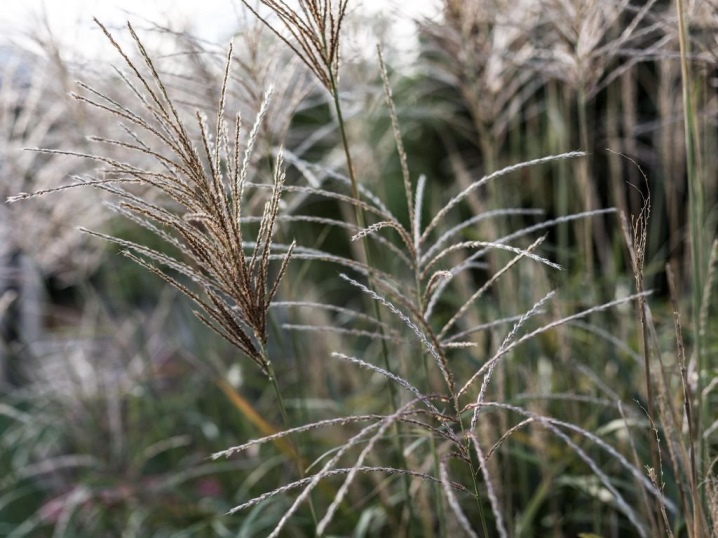
Use in landscape design
The use of miscanthus in landscape design is very extensive. The culture becomes a wonderful backdrop for brighter neighbors, and is planted in groups or even singly. Landings look especially good on the banks of reservoirs, next to gazebos or buildings. The larger the variety grows, the more the center position should be given to it in the garden. Ornamental cereals will look very impressive in rock gardens or rock gardens, but in this case it is important to take care of moisture, since compositions of this type, as a rule, are drought-resistant crops.
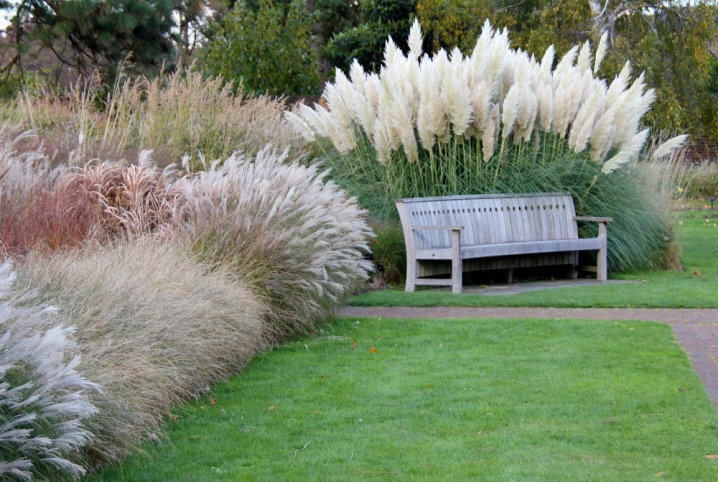
Many landscape designers use miscanthus to form linear mixborders along with brightly colored dwarf shrubs or hosts. The plant can act as a tapeworm in the middle of the lawn or at the point of intersection of paths, or frame the alleys with a living fence. Shrubs with openwork carved leaves, barberries, dahlias, rogers, peonies, phloxes and others are perfect as neighbors for a fan. The choice can be made based on your taste.
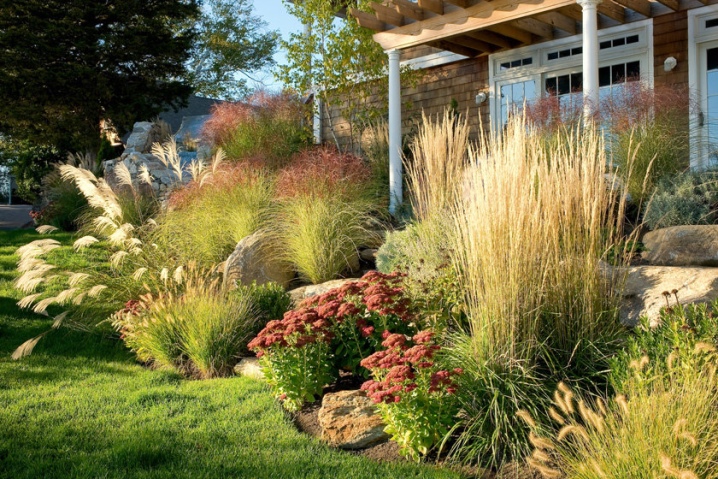
For information on how to properly care for miscanthus, see the next video.



































































The comment was sent successfully.